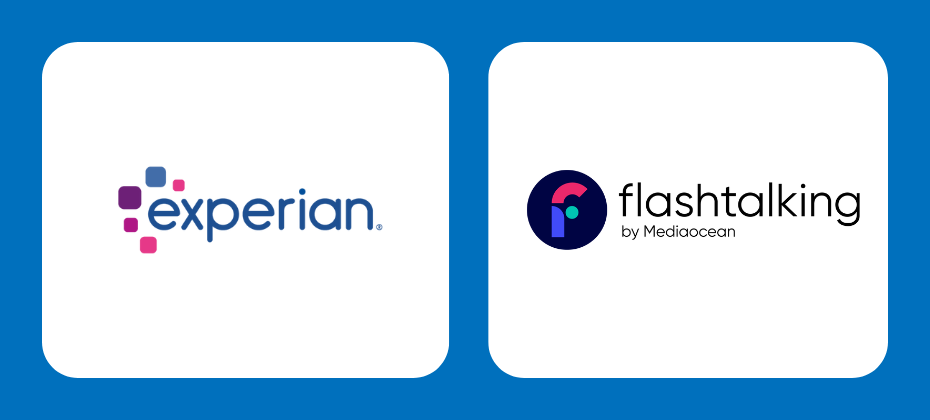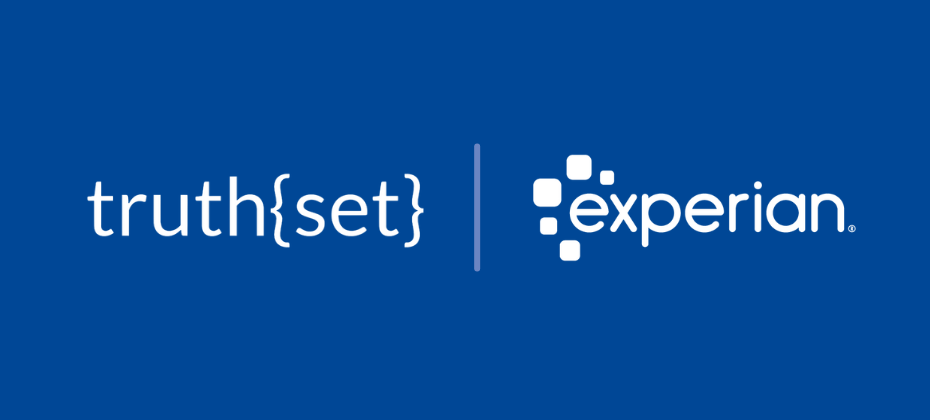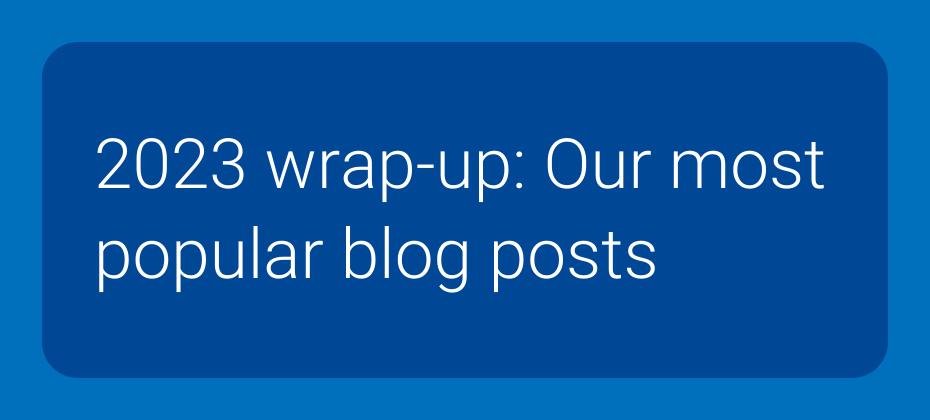All posts by Hayley Schneider, Sr. Manager, Content Marketing

In the ever-evolving and soon-to-be cookieless advertising world, brands and agencies need help finding and maintaining access to accurate and comprehensive marketing data that enables them to reach the audience segments that matter most. Flashtalking by Mediaocean and Experian have a collaboration in place to do just that. Through this partnership, Experian’s more than 2,400 syndicated audiences are available for activation within the Flashtalking platform and its Social Ads Manager. “There are a lot of audience segments and data disappearing within the advertising industry right now because of the deprecation of third-party cookies, but Experian’s syndicated audiences are built for this new privacy-first world. Through this partnership, Flashtalking's clients gain access to some of the industry's most actionable on-the-shelf and custom audience capabilities for activation and targeting across the publishers and social platforms that matter most. It’s as easy as identifying the segments that matter to your brand and activating them everywhere they exist with a few simple clicks.” - Ben Kartzman, COO, Flashtalking by Mediaocean This partnership unites the power of Flashtalking's best-in-class independent omnichannel advertising platform with Experian’s comprehensive audience intelligence, which spans 126 million households and 250 million consumers. “For the same reason that brands are investing more deeply in first-party data in the wake of third-party cookie deprecation, having access to the right audience segments has never been more important. Mediaocean offers access to the only independent ad server that’s powering truly omnichannel, personalized experiences, and we’re thrilled to be amplifying their ability to do that through Experian’s expansive audience segments.” - Colleen Dawe, Director, Sell-Side Sales, Experian The Flashtalking Social Ads Manager has long-standing relationships and technical integrations with all major platforms, including Facebook, Google Demand Gen, Instagram, LinkedIn, Pinterest, Snap, TikTok, and a forthcoming integration with Reddit. Experian data can be deployed through custom and syndicated segments within these platforms, providing clients with both reach and precision. The power of the Experian - Flashtalking collaboration Benefits to marketing organizations that tap Experian data and audience segments via the Flashtalking platform include the following: A unified customer view: Marketers can use Experian's comprehensive data within Flashtalking to create a unified view of the customer across multiple channels. This helps craft cohesive marketing strategies that deliver consistent messages, enhancing customer experiences and brand perception. Enhanced targeting and personalization: Marketers can access Experian's detailed audience segmentation and insights within Flashtalking to target campaigns effectively. They can personalize messages at scale based on demographic, psychographic, and behavioral data to increase engagement and conversion rates across all channels. Optimized cross-channel strategies: With Flashtalking's cross-channel capabilities, marketers can integrate Experian's insights to understand how different segments interact with various channels. This enables the design of optimized cross-channel strategies that cater to the preferences and behaviors of different audiences. Data-driven decision-making: This partnership combines Experian's in-depth consumer insights with Flashtalking's analytics and reporting tools to help marketers make informed decisions. This data-driven approach can improve campaign performance, optimize media spend, and reveal untapped market opportunities. Local market activation: Marketers can also use Experian's geographic and location-based data within Flashtalking to tailor campaigns to local markets. This localized approach can enhance relevance and response rates, providing a competitive edge in regional marketing efforts. Improved media efficiency: This collaboration also enables organizations to harness the power of Experian's data within Flashtalking to improve media planning and buying. They can identify the most effective channels and timeframes for reaching specific audiences, leading to more efficient and cost-effective media investments. Why choose Experian in Flashtalking For over 50 years, we have been a trusted single-source provider of data management solutions. Our expertise in offline and digital identity has enabled us to curate data from over 200 direct and active sources, offering a comprehensive view of consumers with granularity, accuracy and scale. Using this data, we can craft our syndicated audiences to cover many verticals and specialty categories. For example, a Flashtalking client in the automotive industry can supercharge its campaign efforts. Experian has found that automotive advertisers build segmentation using four major data categories: Automotive Demographics Lifestyles and Interests Retail Shoppers: Purchase-Based Directly within the Flashtalking platform, multiple syndicated audiences from Experian in each major data category specific to automotive are available that brands and agencies can activate on-the-shelf to reach consumers with targeted messaging and retargeting. Experian and Flashtalking are future-proofing advertising Together, Flashtalking and Experian will ensure advertisers can continue to deliver personalized, relevant, and impactful messages and experiences to consumers despite ongoing shifts within the data-driven marketing landscape, including the deprecation of third-party cookies in Chrome. This partnership offers greater access to audience segments built on privacy-safe insights with expansive reach, scale, and flexibility. Connect with us to learn more about how you can access Experian’s syndicated audiences through Flashtalking by Mediaocean. Contact us today About Flashtalking by Mediaocean Flashtalking unleashes the power of creative to make media work better. As the leading independent platform for personalization and intelligence across all marketing channels, our Creative Ad Tech bridges the gap between creative and media. We provide AI and automation to connect the silos between teams and deliver more efficient production, versioning, and distribution of creative. Our solutions operate at scale across CTV, Video, Display, Social, Native, Audio, DOOH, and Retail Media channels. As part of Mediaocean, Flashtalking is tied into the industry’s core ad infrastructure for omnichannel planning, buying, and billing. Visit flashtalking.com to learn more. Latest posts

Shoptalk 2024, the premier event for retail and e-commerce professionals, brought together industry leaders to discuss the latest trends and innovations shaping the future of retail. As the retail landscape continues to evolve, here are four key takeaways from Shoptalk 2024: 1. The continuing rise of retail media networks The evolution of retail media is propelling us into a new era of advertising and first-party data monetization. Retailers are using their valuable first-party data to offer targeted advertising opportunities on both their owned and operated channels -- from sponsored content to personalized ads -- and through offsite programmatic ads. However, the full potential of retail media networks (RMNs) is hindered by challenges in understanding and targeting shoppers beyond retail data, reaching customers across channels and validating measurement. To unlock the true value of RMNs, and turn these challenges into opportunities, companies should focus on four areas: Gain insights: Learn more about your customers and the customers your marketing partners care about. Create audiences: Use enriched data to build addressable audience segments for advertisers to target. Maximize reach: Expand your addressability and monetize your data on and off platform. Demonstrate success: Validate marketing impact by connecting ad exposures to outcomes. “It was evident at Shoptalk 2024 that the rise of retail media is unstoppable. The conversations, collaborations, and insights shared at the event cemented the position of retail media networks as the driving force behind the future of commerce.”Alison Hofelich, Sr. Account Executive, Big Box Retail & Grocery 2. Content-led commerce Content is becoming increasingly pivotal in driving commerce, with retailers investing in shoppable video to stimulate conversations and foster customer engagement. While video may not always lead to immediate transactions, it can start dialogues, offering retailers a platform to enhance customer loyalty and influence future sales. Retailers talked about their focus on connecting with Gen Z on a deeper level. PacSun highlighted initiatives like the launch of a gender-fluid line and continuous engagement with young consumers via social media for feedback. Additionally, PacSun talked about embracing "conscious capitalism" by co-creating with influencers and customers, recognizing the growing consumer preference for brands that make a positive impact. By collaborating with influencers and using user-generated content, retailers can create authentic experiences that resonate with their customers. 3. Data privacy and trust With data playing a central role in retail strategies, ensuring data privacy, and building trust with consumers are imperative. Retailers must prioritize transparency and security to safeguard customer information and nurture long-term relationships. While the focus may currently be on capturing Gen Z market share, businesses need to anticipate shifts in consumer demographics and adapt their strategies accordingly. Using customer data in a privacy-compliant way enables retailers to implement effective personalization strategies that drive long-term engagement and loyalty. “Retail media networks were at the center of Shoptalk 2024. In addition to retail media networks, the seamless integration of data to enhance customer personalization and the rising importance of targeting Gen Z were recurring themes."Kai Rood, Account Executive, Retail Apparel 4. The time to embrace AI is now Technology continues to drive innovation in retail, with advancements in AI reshaping the shopping experience. From virtual try-ons to personalized product recommendations, retailers are using AI to engage consumers and enhance product discovery. Testing and learning are essential for AI implementation, as companies navigate the risks and rewards of technological innovation. Navigate the future of retail with Experian Shoptalk 2024 provided invaluable insights into the future of retail, highlighting the importance of retail media networks, content-led commerce, data privacy, and tech innovation. By embracing these trends and innovations, retailers can position themselves for success in an ever-evolving marketplace. At Experian, our solutions are tailored to empower businesses in navigating this dynamic landscape. Through our Consumer Sync solutions, we bridge the gap between online and in-store touchpoints, ensuring a unified strategy for reaching audiences across channels and evaluating campaign performance. Our Consumer View solutions enable you to tap into 5,000 demographic and behavioral attributes to fill in any gaps on your customer. Go beyond category buyers by combining your first-party data and Experian's top ranked data to build custom audiences that lead to higher ROI for your advertisers. Connect with a member of our team today to get started. Latest posts

As the vibrant colors of spring emerge, so do opportunities for marketers to engage with their audience in fresh and meaningful ways. Crafting effective spring advertising campaigns requires a deep understanding of your target audience. In this blog post, we'll explore five key audience categories, each presenting unique opportunities for impactful spring advertising campaigns. What separates Experian's syndicated audiences Experian’s 2,400+ syndicated audiences are available directly on over 30 leading television, social, programmatic advertising platforms, and directly within Audigent for activation within private marketplaces (PMPs). Reach consumers based on who they are, where they live, and their household makeup. Experian ranked #1 in accuracy by Truthset for key demographic attributes. Access to unique audiences through Experian’s Partner Audiences available on Experian’s data marketplace, within Audigent for activation in PMPs and directly on platforms like DirectTV, Dish, Magnite, OpenAP, and The Trade Desk. Spring cleaning and home improvement Embrace the energy of renewal associated with spring cleaning. Target audiences interested in home improvement and organization with Experian syndicated audiences like "Gardening Mothers" or "Home Improvement & DIY Frequent Spenders." Share tips, hacks, and products that align with the desire for a fresh start, turning mundane chores into exciting opportunities for your brand to shine. Here are 6 audience segments that you can activate to target consumers focused on spring cleaning and home improvements: Purchase Transactions > Household Goods > Frequent Spenders Purchase Predictors > Shoppers All Channels > Home Maintenance and Improvement Purchase Transactions > DIY and Advice Seekers > High Spenders Purchase Transactions > Home Improvement/DIY > High Spenders Retail Shoppers: Purchase Based > Home Improvement & DIY > Hardware & Home Improvement Retail Shoppers: Purchase Based > Shopping Behavior > Big Box and Club Stores: Walmart Frequent Spenders Gardening Spring is the time when consumers are investing in gardening equipment for lawn care. Here are a few audience segments you can activate to target consumers focused on gardening: Retail Shoppers: Purchase Based > Home Improvement & DIY > Garden & Landscaping Stores: Frequent Spenders Lifestyle and Interests (Affinity) > Hobbies > Gardening Lifestyle and Interests (Affinity) > Moms, Parents, Families > Gardening Mothers Purchase Predictors > Shoppers All Channels > Lawn and Garden Movers and new homeowners Did you know? 44% of new homeowners are between the ages of 25-39*. Improve engagement for your spring targeting by pairing our new homeowner audiences with our Demographics > Ages > 25-29, 30-34, and 35-39 syndicated audiences. Here are a few you can activate now: Life Events > New Homeowners > Last 6 Months Life Events > New Movers > Last 12 Months Mother's Day: Unveil the perfect gift Appealing to the emotion of gratitude and love, Mother's Day is a significant occasion for marketers. Activate Experian syndicated audiences such as "Mother's Day Shoppers" and "Florists & Flower Gifts High Spenders" to tailor your spring advertising campaign toward those likely to purchase heartfelt gifts. Share ideas and promotions that resonate with the nurturing and caring spirit of this celebration. Here are 6 audience segments that you can activate to target consumers getting ready to celebrate Mother's Day: Retail Shoppers: Purchase Based > Seasonal > Mothers Day Shoppers Spenders Lifestyle and Interests (Affinity) > Moms, Parents, Families > Mothers with 2+ children Mobile Location Models > Visits > Mothers Day Shoppers Lifestyle and Interests (Affinity) > Moms, Parents, Families > Moms Age 25-54 Mobile Location Models > Visits > Jewelry Retail Stores Retail Shoppers: Purchase Based > Shopping Behavior > Florists & Flower Gifts: High Spenders Father's Day: Celebrate Dads in style Highlighting the significance of paternal bonds, Father's Day is an excellent opportunity to showcase thoughtful gifts and experiences. Engage the "Father's Day Shoppers" or "Growing and Expanding families" with content and products aligned with their interests. Craft a campaign that acknowledges the varied roles fathers play and the unique gifts they would appreciate. Here are 6 audience segments that you can activate to target consumers getting ready to celebrate Father's Day: Retail Shoppers: Purchase Based > Seasonal > Fathers Day Shoppers Spenders Mobile Location Models > Visits > Fathers Day Shoppers Mosaic - Personas - Lifestyle and Interests > Group M: Families in Motion > M45 - Growing and Expanding (Young, working-class families and single parent households that live in small city residences) Geo-Indexed > Demographics > Presence of Children: Ages: 7-9 Lifestyle and Interests (Affinity) > Activities and Entertainment > Home Improvement Spenders Life Events > New Parents > Child Age 0-36 Months Plan for the 2024 TV Upfronts When gearing up for the 2024 upfronts, you can expand your TV planning by incorporating diverse audience categories into your spring advertising campaigns. It's not just about targeting a demographic; it's about captivating your unique audience. Whether it's cord cutters, ad avoiders, avid streamers, or households that watch TV together, understanding and engaging with these distinct segments is paramount. To maximize impact, use comprehensive TV data that goes beyond broad demographics. Here are 6 audience segments that you can activate as part of your TV planning strategy: Retail Shoppers: Purchase Based > Entertainment > Streaming/Video/Audio/CTV/Cable TV: Cable/Broadcast TV: Cord Cutters: Recent Retail Shoppers: Purchase Based > Entertainment > Streaming/Video/Audio/CTV/Cable TV: Streaming Video: High Spenders Television (TV) > Ad Avoiders/Ad Acceptors > Ad Avoiders Television (TV) > TV Enthusiasts > Paid TV High Spenders Television (TV) > Ad Avoiders/Ad Acceptors > Ad Acceptors Television (TV) > Household/Family Viewing > Pay TV/vMVPD Subscribers Households To find consumers who are most likely to engage with your TV ads, you can layer in our TrueTouchTM engagement channel audiences: TrueTouch: Communication Preferences > Engagement Channel Preference > Digital Video TrueTouch: Communication Preferences > Engagement Channel Preference > Streaming TV Summer preparation: Anticipate the fun ahead As spring transitions to summer, help your audience gear up for the upcoming season. Target "Summer break travelers" or "Memorial Day Shoppers" with offerings that align with their summer plans. Whether it's fashion, travel essentials, or outdoor gear, position your brand as an essential companion for their summer adventures. Here are 6 audience segments that you can activate to target consumers getting ready for summer: Mobile Location Models > Visits > Summer Break Travelers Retail Shoppers: Purchase Based > Seasonal > Summer Sales Event Shoppers: Independence Day Shoppers Retail Shoppers: Purchase Based > Travel > Vacation/Leisure Travelers: Summer Trips Mosaic - Personas - Lifestyle and Interests > Group B: Flourishing Families > B09 - Family Fun-tastic (Upscale, middle-aged families with older children that live in suburban areas and lead busy lives focused on their children) Mobile Location Models > Visits > Memorial Day Shoppers Retail Shoppers: Purchase Based > Seasonal > Summer Sales Event Shoppers: High Spenders: Memorial Day Shoppers Did you know? Consumers between the age of 45-49 make up the largest percentage of top apparel shoppers*. Improve engagement for summer apparel shopping targeting by refining your audience with our Demographics > Ages > 45-49 syndicated audience. Spring into effective advertising with Experian’s syndicated audiences For spring advertising campaigns, understanding your audience is the key to success. By activating Experian's syndicated audiences, you can refine your approach and resonate by activating specific segments. Embrace our syndicated audiences so you deliver campaigns that not only capture attention but also build lasting connections with your audience. As you embark on this spring marketing journey, remember – the possibilities are as endless as the blossoming flowers. Connect with our audience team Need a custom audience? Reach out to our audience team and we can help you build and activate an Experian audience on the platform of your choice. Additionally, work with Experian’s network of data providers to build audiences and send to an Audigent PMP for activation. You can activate our syndicated audiences on-the-shelf of most major platforms. For a full list of Experian's syndicated audiences and activation destinations, download our syndicated audiences guide below. Download our syndicated audiences guide Check out other seasonal audiences you can activate today. Take me there Footnote *Experian looked at our demographic and purchase-based data to understand retail trends over the past year. Our demographic and purchase-based data covers credit and debit card usage across 500 top merchants. Latest posts

As we approach the 2024 election season, the advertising landscape is poised for tremendous growth, with political ad spending projected to surpass $10 billion. With Kamala Harris entering the race, spending priorities have moved, especially in key states like Ohio, where the Senate race alone has already seen $300 million in ad spending. Connected TV’s (CTV’s) share of political ad spending is set to jump from 2.7% in 2020 to 12.8% this year. The Harris campaign is leading the charge, allocating $200 million for digital ads, much of which will go to streaming platforms. During this political campaign marketing season, effective audience targeting is crucial, as it holds the potential to sway voters, shape public opinion, and ultimately determine election outcomes. In this blog post, we'll highlight political audiences that can assist political campaigns and organizations in connecting with their desired audiences in a meaningful and impactful way. What separates Experian's syndicated audiences Experian’s 2,400+ syndicated audiences are available directly on over 30 leading television, social, programmatic advertising platforms, and directly within Audigent for activation within private marketplaces (PMPs). Reach consumers based on who they are, where they live, and their household makeup. Experian ranked #1 in accuracy by Truthset for key demographic attributes. Access to unique audiences through Experian’s Partner Audiences available on Experian’s data marketplace, within Audigent for activation in PMPs and directly on platforms like DirectTV, Dish, Magnite, OpenAP, and The Trade Desk. Three political campaign marketing audience categories Over 240 politically relevant audiences are available on-the-shelf of leading TV, demand, and supply platforms to help your political partners gain share based on three political audience categories: Political affiliations Political personas Relevant ballot initiative audiences Let's break down each category and which audiences you can use in your political campaign marketing to target voters this upcoming election season. Political affiliations Target audiences could include those who are likely to be in the Democratic, Independent, or Republican parties, or are likely to not be registered to a political party. Our political affiliation audiences use a foundation of voter registration data with Experian's advanced statistical models to reach voters at scale, based on their political party. Here are four audience segments that you can activate to target voters based on their predicted party affiliation: Political Affiliation > Democrat Political Affiliation > Republican Political Affiliation > Independent/Other Political Affiliation > Unregistered Political personas One key target audience could be voters who are likely to be influenced by a political candidate's renewable energy program. Additional target audiences could include those who are likely to be influenced by a candidate's position on the economy or healthcare. Here are 10 audience segments that you can activate to target voters based on their viewpoints on key political issues: Political Personas > Political Unregistered Liberal Leaning Political Personas > Political Unregistered Conservative Leaning Political Personas > Committed Democrats Political Personas > Moderate Democrats Political Personas > Political Leaning Liberals Political Personas > Liberal Leaning Independents Political Personas > Conservative Leaning Independent Political Personas > Political Leaning Conservatives Political Personas > Moderate Republicans Political Personas > Committed Republicans To reach voters who believe the environment is a key political issue, you can layer in our GreenAware audiences with our Political Personas audiences: GreenAware > Behavioral Greens GreenAware > Think Greens GreenAware > Potential Greens GreenAware > True Browns Psychographic/Attitudes > Shopping Behavior > Smart Greens To reach voters based on their regional voting patterns, you can use our new battleground counties and district audiences: Affiliation Switcher Counties Battleground Counties House Battleground Districts Democrat Counties Republican Counties Independent Counties Relevant ballot initiative audiences You can also reach voters based on their attitudes and behaviors related to key ballot measures. Let's walk through a few examples below and highlight relevant syndicated audiences that you can activate during the 2024 political campaign marketing season. Local and national ballot initiative support Consumer behaviors are often great predictors of down-ballot initiatives. For example, military families may show favor toward initiatives supporting veterans, households with children present may show more interest in school funding, and those interested in the environment will favor green initiatives. Experian offers an array of consumer behavior and interests audiences to help you fine-tune your targeting and messaging strategies. Lifestyle and Interests (Affinity) > Occupation > Military – Active Demographics > Presence of Children > Ages: 0-18 Charitable causes Understanding where consumers are actively donating to charitable causes paints a clear picture into their political interests. Lifestyle and Interests (Affinity) > Charitable Causes > Contributes to Political Charities Consumer Financial Insights > Discretionary Spend - Donations > $1,000-$1,999 Demographics Demographics play a critical role into voter opinions with presence of children, age, and household income influencing decisions at the polls. Geo-Indexed > Demographics > Household Income: $50,000-$74,999 Geo-Indexed > Demographics > Education: Bachelor Degree Demographics > Presence of Children > Ages: 10-12 Demographics > Marital status > Single Demographics > Ages > 19-24 Lifestyle and Interests (Affinity) > Moms, Parents, Families > Mothers with infant child(ren) (0-3 yrs old) Millions of campaign dollars were wasted in the 2022 midterm elections when voters were targeted with ads for issues and candidates they couldn’t vote for. Using advances in geo-targeting can help save wasted spend and ensure relevant messages reach the right voters. Finance Income and large financial decisions often trigger changes in perspective and influence voter behaviors. Financial FLA Friendly1 > Income > $1,000-$24,999 Financial FLA Friendly > In Market New Mortgage Financial FLA Friendly > In Market Auto Loan Media consumption and engagement Media consumption and engagement offers great insights into how voter interest, current channel engagement, and engagement in political issues. TrueTouch: Communication Preferences > Engagement Channel Preference > Email Engagement TrueTouch: Communication Preferences > Engagement Channel Preference > Streaming TV Social Media > Snapchat Purchase Transactions > Ad Responders > Digital Television (TV) > Ad Avoiders/Ad Acceptors > Ad Acceptors Mosaic Proprietary persona-based audience solution that combines demographic and behavioral data to create a holistic view of voters and their interests. Mosaic - Personas - Lifestyle and Interests > Group O: Singles and Starters > O55 - Family Troopers Occupation Provides the opportunity to deliver targeted messaging on measures based on a consumer’s occupation. Demographics > Occupation > Management/Business and Financial Operations Demographics > Occupation > Sales Demographics > Occupation > Farming/Fish/Forestry Consumer Behaviors > At-Home: Retired/Empty Nesters Consumer Behaviors > Occupation: Education Personal views Understand consumers personal views around family, their social and work life. Psychographic/Attitudes > Personal Views > Work Centered Psychographic/Attitudes > Personal Views > Family Centered Psychographic/Attitudes > Personal Views > Social Isolation We can help you match your message to your audience With Experian's political audiences, you can confidently execute your political campaign marketing, knowing our audiences are based on voter registration data and advanced predictive technology. Our highly accurate models are validated by our expert audience team to ensure precise targeting and drive impact and influence with the right audience. We understand that finding a trusted data provider can be a challenge, which is why we make it easy to access our syndicated audiences. For a full list of all of Experian's syndicated audiences, download our syndicated audiences guide. Download our syndicated audiences guide You can activate our political audiences on-the-shelf of most major platforms. Can't find the audience you're looking for or need a custom audience? Connect with our audience team for more information. Additionally, work with Experian’s network of data providers to build audiences and send to an Audigent PMP for activation. Connect with our audience team Footnote “Fair Lending Friendly” indicates data fields that Experian has made available without use of certain demographic attributes that may increase the likelihood of discriminatory practices prohibited by the Fair Housing Act (“FHA”) and Equal Credit Opportunity Act (“ECOA”). These excluded attributes include, but may not be limited to, race, color, religion, national origin, sex, marital status, age, disability, handicap, family status, ancestry, sexual orientation, unfavorable military discharge, and gender. Experian’s provision of Fair Lending Friendly indicators does not constitute legal advice or otherwise assures your compliance with the FHA, ECOA, or any other applicable laws. Clients should seek legal advice with respect to your use of data in connection with lending decisions or application and compliance with applicable laws. Latest posts

Every year, the Experian team attends the Consumer Electronics Show (CES) in Las Vegas, to immerse ourselves in the world's most significant consumer tech showcase and stay at the forefront of the latest technological advancements and innovations that shape the AdTech industry. This year's event was a vibrant melting pot of innovation and vision, from streamers taking a bigger bite of the advertising pie to the emergence of AI-powered solutions and drone delivery services. Amidst these advancements, the dynamic interplay of technology, media, and advertising raised important questions, especially in the context of evolving regulations and cookie deprecation. During CES, we captured insights from various thought leaders, and in the coming months, we'll be sharing these valuable perspectives with you. Watch the video below for full insights coming from our content studio onsite during the event. Or, keep reading for a recap on four key trends from CES and what they mean for your business in 2024! “My first CES was a major success. You could feel the buzz in the air as new ideas and partnerships were being created within and across industries. The intersection of the different players within retail media, connected TV, retail technology, the demand and supply-side, and agencies all in an ever-changing world of regulation and privacy begs for a solution that can maximize a successful outcome for all.”anne passon, sr director, sales, retail & cpg 1. Audience targeting: How first- and third-party data work together A central theme at CES was the importance of audience targeting, highlighting the crucial role of first-party data. However, it’s clear that to maximize its potential, this data needs to be augmented with sophisticated identity solutions and enriched with third-party insights, all while navigating the complexities of privacy regulations. This integrated approach is vital to understanding audiences and for creating more effective marketing strategies that comply with privacy regulations. 2. Standardizing metrics in retail media networks The challenges around retail media networks, particularly in terms of standardizing metrics like incremental return on ad spend (iROAS), were a hot topic at CES. This complexity around this topic underscores the need for neutral, expert third parties to help bring clarity and consensus, aiding businesses in navigating this multifaceted domain. 3. The challenge of switching data solutions Discussions covered the broader challenges associated with transitioning to new data solutions. For businesses, this involves a critical assessment of the benefits versus the costs and complexities of adopting new platforms or systems. This decision-making process is increasingly significant as data strategies become integral to marketing success. 4. Identity solutions in a cookieless future With the industry moving toward a cookieless future, the spotlight at CES was on the importance of robust identity solutions. Understanding the functionality and necessity of various universal IDs is essential to minimize data loss and maintain effective targeting. Investing in flexible and adaptable identity solutions like the Experian Graph is essential to maintain effective targeting and audience engagement in this new landscape. Announcements and advertising innovations at CES 2024 CES was a stage for significant announcements and innovative marketing initiatives: Criteo and Albertsons announced their collaboration in retail media. Instacart's partnership with Google for enhanced shopping ads and AI shopping carts. NBCUniversal's advancements in streamlining programmatic advertising. Brands like Netflix, LG, Freewheel, and Amazon Ads also captured attention with their creative marketing strategies, ranging from unique collaborations to themed promotions and captivating events. These insights from CES provide a glimpse into the future of technology, media, and advertising. They highlight the need for adaptability, innovation, and informed decision-making in these dynamic industries, especially in the context of privacy regulations. Stay tuned for our series of posts where we'll dive deeper into these topics, sharing exclusive insights from industry thought leaders. Follow us on LinkedIn or sign up for our email newsletter for more informative content on the latest industry insights and data-driven marketing. Contact us Latest posts

Experian continues to lead in data accuracy according to Truthset's latest analysis.

As we approach 2024, marketers must grasp the evolving landscape of digital activation. Understanding emerging audience trends and activation strategies is key to developing impactful marketing initiatives and positioning your brand for success. In Experian's 2024 Digital audience trends and predictions report you'll find: Data-driven insights that will empower you to confidently develop marketing strategies that resonate with your audience and drive meaningful results. Insights from Experian experts and our industry-leading data. Our outlook for 2024 marketing trends. In this blog post, we'll provide a sneak peek of the 2024 marketing trends you can expect in our full report. Digital activation Digital activation grew by 63% between 2022 and 2023. We expect digital activation to increase in 2024 but at a slower rate than in 2023 due to economic uncertainty caused by high-interest rates, recent state privacy regulations, and work stoppages in the entertainment and automotive industries. Top digital audiences Which digital audiences are advertisers purchasing from Experian? We are seeing growth in four major data categories: Automotive, Demographics, Lifestyle and Interests, and Retail Shoppers: Purchase Based audiences. Here are a few audiences within these categories that you can activate on-the-shelf of your preferred platform: Automotive: Autos, Cars, and Trucks > In Market-Make and Models Demographics: Demographics > Homeowners/Renters > Renter Lifestyle and Interests: Lifestyle and Interests (Affinity) > Activities and Entertainment > Wine Lovers Retail Shoppers: Purchase Based: Retail Shoppers: Purchase Based > Food and Drink > Restaurants: Fast Food/QSR Chicken Frequent Spenders Top digital audiences by industry What are the top digital audiences being activated by industry? Download our 2024 Digital audience trends and predictions report to discover the top digital audiences in the following industries: Automotive Health Financial Services Retail & CPG Download our new 2026 Digital trends and predictions report Marketing in 2026 will be defined by connection: between activation and measurement, data and AI, platforms and outcomes. These connections are what turn innovation into impact, and they’re where Experian helps marketers lead with confidence. What you'll learn AI is only as good as its data : Find out why the marketers who shape how AI works, with high-integrity, human-centered data, will be the ones who lead. Activation and measurement are coming together: Explore how marketers are shifting from reporting after the fact to guiding performance in the moment. First-party data activation is becoming a foundational capability: See how it's now possible to onboard and activate privacy-compliant audiences across channels, all from a single system. Commerce media is no longer just a retail play: Understand why auto, CPG, financial services, and travel brands are now adopting retail-style models to connect data, media, and sales outcomes. Curation is the new programmatic standard: Learn how curation brings identity, quality, and control together, allowing marketers to target confidently across connected TV (CTV), audio, and the open web. Download now Contact us Latest posts

2023 has been an unprecedented year for AdTech. With new challenges arising every day — from ongoing signal loss to changing consumer privacy regulations– staying on top of trends is more important than ever before. To help you stay informed on successful tactics from across our ecosystem we’ve compiled a list of our top five 2023 AdTech blog posts. Keep reading to learn about the top themes from CES and Cannes this year, why contextual targeting is so popular, and more - so you can remain competitive in today's rapidly changing environment. #5 CES 2023: Clean rooms, activation, and more Experian attended CES in January to kick off the AdTech year, connecting with partners, clients, and industry leaders to understand their challenges and goals. Discussions were focused on clean rooms and digital activation to address data deprecation and consumer privacy. Clean rooms have the potential to standardize data and address interoperability issues. Digital activation was predicted to increase significantly in 2023, with more focus on demand-side, video, and supply-side platforms. Did digital activation increase in 2023? Download our 2024 Digital audience trends and predictions report to find out. Read our full 2023 CES recap here. #4 Experian identity resolution now available in AWS Clean Rooms Earlier this year, Experian announced that our identity resolution solution is now available in AWS Clean Rooms. Through this new partnership, customers can pair Experian's identity capabilities with AWS Clean Rooms to safely collaborate and access deeper insights without exposing sensitive data. Check out the full announcement to hear from Kalyani Koppisetti, Principal Partner Solution Architect at AWS, Matt Miller, Business Development Principal at AWS, and Tyler Middleton, Sr. Partner Marketing Manager at Experian. #3 Four key themes from Cannes Lions 2023 At Cannes Lions 2023, discussions revolved around four main themes: Signal loss: Experts discussed the importance of adapting paid media strategies to align with consumer behaviors. Collaboration: Discussions highlighted the need for industry players to collaborate and focus on solutions that benefit all stakeholders in the ecosystem. Personalization: This was a key topic and emphasized the growing significance of tailored content, data-driven insights, and first-party data solutions for advertisers adapting to cookie deprecation and the evolving consumer privacy landscape. Balancing AI and creativity: Attendees explored how to balance AI capabilities and nurture creativity while maintaining a human touch. Cannes 2024 will be here before we know it and Experian will be there. To get ready, check out this post by Tyler Middleton, Sr. Partner Marketing Manager, to hear from a first-time Cannes attendee, #2 Three key insights from our 2023 Holiday spending report Experian's annual Holiday spending trends and insights report analyzed recent trends, consumer spending habits, and anticipated what was to come in the 2023 holiday shopping season. This blog post covered three key insights from our report: Consumers are starting their holiday shopping earlier, particularly with online sales. Online sales have been increasing year-over-year, surpassing in-store sales. Spending during the 2022 holiday season was lower than in previous years but is expected to be on par with what was seen in 2023. For advice from our experts and access to all of our predictions for this year’s holiday shopping season, download our 2023 Holiday spending trends and insights report today. #1 How contextual ad targeting addresses signal loss Our most viewed blog post of 2023 was How contextual ad targeting addresses signal loss. Marketers are seeking new solutions due to signal loss caused by the phasing out of third-party cookies. Contextual ad targeting offers a way to combine contextual signals with machine learning for more accurate targeting. Experian's Jason Andersen and Yieldmo's Alex Johnston discuss the challenges of signal loss, addressability, the importance of good creative, and tips for digital ad success in this blog post. By understanding contextual advertising, marketers can create powerful and effective campaigns to reach target audiences. Subscribe to our newsletter Sign up for our email newsletter to receive our latest blog posts, product and partnership announcements, thought leadership, and more straight to your inbox. Subscribe Contact us today Latest posts

The digital advertising landscape is undergoing a significant transformation with the gradual deprecation of third-party cookies. This shift necessitates the adoption of new strategies for audience targeting and data management. In our next Ask the Expert segment, we explore this evolution, discussing new strategies for audience targeting and data management in a world without cookies. We’re joined by industry leaders, Gabe Richman, Senior Director of Data Partnerships at The Trade Desk, and Chris Feo, Experian’s SVP of Sales & Partnership who spotlight The Trade Desk’s innovative approach to navigating a cookieless future. Tune in to our Q&A below to learn more about these topics and learn how the collaborative efforts of Experian and The Trade Desk offer a glimpse into the future of advertising. Cookieless IDs are the new face of identity in advertising Traditional tracking and targeting techniques are being replaced by more advanced and privacy-conscious methods. Unified I.D. 2.0 (UID2), led by The Trade Desk, exemplifies this shift, offering a new identifier based on encrypted email addresses or phone numbers. This approach not only caters to the evolving privacy regulations but also places greater control in the hands of consumers. UID2’s design fundamentally differs from cookies since it is rooted in transparency and consumer consent. UID2: A catalyst for industry-wide adoption UID2’s journey reflects a rising industry-wide recognition of its value across the industry. The adoption of UID2 by major publishers, demand-side platforms, and advertisers indicates a shift toward more sustainable and consumer-friendly approaches to identity in advertising. This is particularly evident in areas like connected TV (CTV), where UID2 is rapidly becoming a currency and standard. “The purpose of UID2 is not only to create a better ID for advertisers and publishers to achieve their objectives, but also to benefit the consumers. Unlike cookies, UID2 provides transparency and control to the consumers for the first time.”gabe richman, sr. director, data partnerships, the trade desk How Experian and The Trade Desk work together The partnership between The Trade Desk and Experian goes beyond adapting to the absence of cookies. Our joint efforts highlight a commitment to developing solutions that cater to advertiser’s needs while respecting consumer privacy, a balancing act becoming increasingly crucial in today’s digital ecosystem. The Trade Desk's emphasis on UID2 as a foundational element in the open web, campaign design, and activation is a testament to the potential of new identifiers in enhancing advertising efficacy. Similarly, our ability to utilize these identifiers to deliver detailed audience insights offers advertisers a powerful tool to remain effective in a post-cookie world. Experian’s role in the adoption of UID2 Experian's integration strategies have played a critical role in diversifying the applications of UID2. By partnering with The Trade Desk, we help broaden the reach and effectiveness of UID2 across various advertising channels. In terms of reach – by incorporating a prominent cookieless ID, we further amplify the reach of UID2. The increased adoption of this new ID allows the digital ecosystem the ability to interact using an alternative identifier, thereby broadening the potential audience. In terms of effectiveness – we help advertisers serve relevant ads to the right audiences, ensuring the relevance of the ads and control over their frequency. Targeting with Geo-Indexed audiences The Trade Desk works with Experian to ingest and host our syndicated audiences. This partnership gives The Trade Desk’s clients access to over 2,400 syndicated audiences that span across eight verticals. This includes access to our new Geo-Indexed audiences that allow brands to reach consumers and households based on geographic regions that over-index for a common set of attributes, ultimately offering brands a targeting solution that prioritizes both consumer privacy and accuracy. What a future beyond cookies looks like Looking ahead, the focus in advertising is not solely on replacing cookies but on a broader evolution of the industry. This includes continuing to apply machine learning technologies, like artificial intelligence (AI), to enhance ad personalization and effectiveness. The interplay between creative content, audience insights, and privacy-compliant targeting will become increasingly important as the industry evolves. As cookies become a thing of the past, the initiatives spearheaded by The Trade Desk and Experian will likely set the tone for the next era of digital advertising, and emerging solutions like UID2 are leading the way. Watch the full Q&A Visit our Ask the Expert content hub to watch Gabe and Chris' full conversation about cookieless advertising. In their conversation, Gabe and Chris share more about UID2, consumer transparency, and the importance of consumer data for targeted advertising. Connect with us About our experts Gabe Richman, Sr. Director, Data Partnerships, The Trade Desk Gabe Richman is the Senior Director of Data Partnerships at The Trade Desk where he focuses on global identity strategy and platform partnerships as well as driving UID2 and EUID adoption across the broader ecosystem. Prior to joining The Trade Desk in 2021, Gabe held various roles in AdTech at HealthVerity, Wunderkind and LiveRamp. For the last decade Gabe has taken pride in helping advertisers and platforms alike demystify the complex identity landscape and embrace the change needed to preserve the open internet. Gabe is a graduate of the University of Maryland and resides in Los Angeles. Chris Feo, SVP, Sales & Partnerships, Experian As SVP of Sales & Partnerships, Chris has over a decade of experience across identity, data, and programmatic. Chris joined Experian during the Tapad acquisition in November 2020. He joined Tapad with less than 10 employees and has been part of the executive team through both the Telenor and Experian acquisitions. He’s an active advisor, board member, and investor within the AdTech ecosystem. Outside of work, he’s a die-hard golfer, frequent traveler, and husband to his wife, two dogs, and two goats! Latest posts
